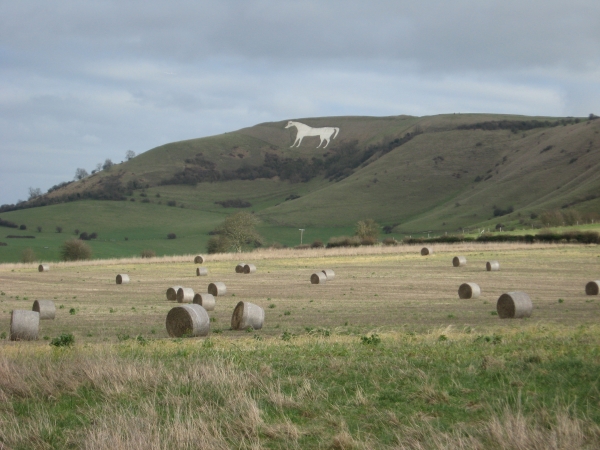|
|
|
|
The Westbury White Horse proclaims itself to be the oldest of Wiltshire's White Horses - quite reasonably, as the rather older one above Uffington in the Vale of the White Horse is in point of fact in Berkshire. It was carved sometime in the earlier half of the 18th century and has been periodically recut since. There are also several more along the valley eastwards from Westbury towards Pewsey, usually visible from the Kennet and Avon Canal; a couple of these are drawn in a cantering pose. Uffington's has a certain air of a leaping horse; Westbury's horse is more tranquil, standing on the side of the hill between feedings and contemplating the world. It is also undeniably a horse. Uffington's is rather more of a cave-painting rendition. Both are remarkable achievements, considering that the person on the hillside cutting out the horse can only have the vaguest idea of where exactly they were supposed to be making the next cut. The horse only fully gains its proportions - which are carefully crafted to take into account the slope of the hill and a normal viewing position of somewhere in the vicinity of a railway built a century after it appeared - when the viewer is a mile or so away. Close up it is inclined to more bear an air of a patch of hillside where the topsoil has been removed with bits sticking out at random - at least, it would if certain 1950s fashions hadn't led to it being cast in concrete. Periodically it is illuminated at nights, aiming to give an air of a very large horse standing in the sky. The Horse backs onto the Bratton Camp hill fort, although there is not currently believed to be any connection between the two. The military connection subsequently moved to a more recent hill fort at nearby Warminster and now occupies the Imber Ranges, which seals off several thousand acres of prime walking upland behind "No Entry" signs and expositions on by-laws from November 1963. The town of Westbury is otherwise notable for remarkably little, being a moderately attractive Wiltshire town in surroundings that consist of hills, fields and business estates. A nearby cement works closed some years ago. The railway station, served by various semi-fast trains, is a junction strategically located well out of town (which is on the other side of the station's avoiding line). It also provides a hub for local quarry traffic. |
